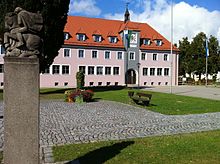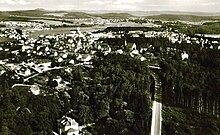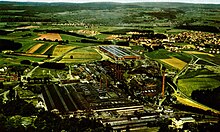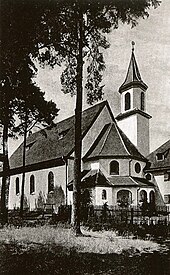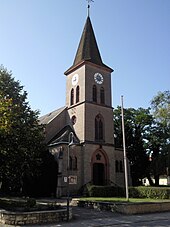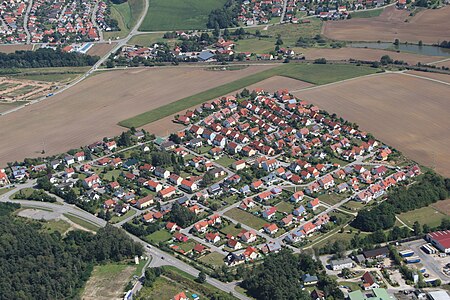Maxhütte-Haidhof
| coat of arms | Germany map | |
|---|---|---|

|
Coordinates: 49 ° 12 ' N , 12 ° 6' E |
|
| Basic data | ||
| State : | Bavaria | |
| Administrative region : | Upper Palatinate | |
| County : | Schwandorf | |
| Height : | 416 m above sea level NHN | |
| Area : | 34.7 km 2 | |
| Residents: | 11,787 (Dec. 31, 2019) | |
| Population density : | 340 inhabitants per km 2 | |
| Postal code : | 93142 | |
| Area code : | 09471 | |
| License plate : | SAD, BUL , NAB , NEN, OVI, ROD | |
| Community key : | 09 3 76 141 | |
| LOCODE : | DE XTH | |
| City structure: | 40 districts | |
City administration address : |
Regensburger Strasse 18 93142 Maxhütte-Haidhof |
|
| Website : | ||
| Mayor : | Rudolf Seidl (Independent Voters Maxhütte-Haidhof, UWM) | |
| Location of the town of Maxhütte-Haidhof in the Schwandorf district | ||
Maxhütte-Haidhof is a town in the Upper Palatinate district of Schwandorf .
geography
Maxhütte-Haidhof is centrally located in the middle Upper Palatinate in the city triangle Teublitz , Burglengenfeld and Maxhütte-Haidhof, on the border with the Bavarian Forest. It is 29 km to Regensburg , the capital of the Upper Palatinate, and 14 km to the large district town of Schwandorf .
City structure
The city of Maxhütte-Haidhof consists of the following 40 districts:
- Almenhof
- Almenhöhe
- Berghof
- Binkenhof
- Birch height
- Birch cell
- Blattenhof
- Bruecklhof
- Brunnheim
- Deglhof
- Eichelberg
- Engelbrunn
- Fürsthof
- Haidhof
- Harberhof
- Haugshöhe
- Ibenthann
- Kappl
- Katzheim
- Kreilnberg
- Feudal house
- Leonberg
- Linter mill
- Maxhütte
- Messnerskreith
- Pfaltermühle
- Pirkensee
- Ponholz
- Rappenbügl
- Roding
- Rohrhof
- Rossbach
- Roßbergeröd
- Schwarzhof
- Stadlhof
- Steinhof
- Strieglhof
- Verau
- Winkerling
- Brick hut
history
The places in the area of today's city of Maxhütte-Haidhof in the Upper Palatinate belonged to the Duchy of Palatinate-Neuburg and its court Lengenfeld. In 1777 they came to the Electorate of Bavaria.
From the rural community of Ibenthann to the city of Maxhütte
The town of Maxhütte-Haidhof itself came into being when the Ibenthann community was renamed Maxhütte on April 26, 1938 and merged with the Meßnerskreith community on February 1, 1956 to form the new Maxhütte-Haidhof community.
The rural community Ibenthann was formed from the localities of the villages Ibenthann, Roding and Winkerling with the homesteads Sauforst, Rohrhof, Strieglhof and Steinhof. Maxhütte, Maxzeche, Luisenzeche, Bergschenke, Kieshaus, Neuhaus (today all in the Maxhütte area), Oberstrieglhof, Deglhof, Roßbergeröd and Birkenzell emerged as settlements.
etymology
The meaning and meaning of the name Ibenthann is difficult to clarify properly. The most widespread opinion is that the name should be associated with the yew tree, as it is believed that Louis XIV bought yew trees from this area as "German yew wood". Ibenthann would therefore come from Eibenthann, yew was formed from 'Iwa' or 'Iba'. Etymologically, this word origin would be less easy to explain, as "egg" very rarely became "I".
Older documents can be found 1610 Ibenthan, 1589 Ybenthan, 1538 Uebenthann, 1497 Innthan and 1437 Ymptann.
Ibenthann derives another attempt at an explanation from the Old High German word 'impi' (Middle High German 'imbe' and New High German 'Imme'), meaning bee. The orientation object (when the village was founded) was formed by a few or more fir trees that were populated by wild bees. The “Haidhof” and the “Auf der Haid” fields seem to support the assumption.
The main state archive gives the simplest and most obvious explanation: “A document from 1437 has the form Ymptann. This form clearly shows the origin of the name: in the Tann or in the Tann (imptann). The letter p is often inserted between the word-closing m and the beginning t . "
On April 26, 1938, the name of the community was changed and from then on was named after its largest town:
" Change of place name. By decree of the Reich Governor in Bavaria of April 26, 1938 Zch. Wd 4/18; 2 it was determined that the name of the community Ibenthann, district office Burglengenfeld, will be changed to 'Maxhütte'. "
City foundation and incorporations
In 1953 the community of Maxhütte was elevated to a town . On February 1, 1956, the town of Maxhütte merged with the municipality of Meßnerskreith to form the new town of Maxhütte-Haidhof. On January 1, 1972, Leonberg and Pirkensee were incorporated . On May 1, 1978, the previously independent municipality of Ponholz ( district of Regensburg ) was dissolved and its main part was incorporated into the city of Maxhütte-Haidhof.
historical development
In the year 1280 in the Urbarium Baiuwarae Transdanubianae the first documentary mention of two farms in the "Sauforst" took place. In the text of the document it says: “De duabus Curiis Schawenforst”. In the Vicedominatus Lengvelt a Plach appears as the owner of the two farms in 1326: “Schawenforst due Curie […] Placho habet.” In 1233 Leonberg was named Limperc. Pirkensee appears for the first time in 1326 in the Salbuch. Around 1800 the term “foam forest” and “saum forest” is used for the first time, and later in 1845, around the time of the first coal research, the term “Sauforst”. The origin of the name "Sauforst" lies in the fact that the forest between Burglengenfeld and Maxhütte completely obstructed the view from the fortress Lengenfeld to the east, which is threatened by the enemy, so that - similar to the Schaubergen and -steinen - a show post was issued for security had to become. Place names of analogous origin are Schaumburg and Schaumstein. In 1820 the Sauforst had 14 inhabitants. The fields of employment at that time were agriculture.
In 1835 this situation changed. It is said in the vernacular that deep trenches were washed out by a bad thunderstorm at Verau, whereby a brownish mass appeared. A master locksmith from Leonberg, it is said, was the first to take pieces of coal home with him from this site to see if they were suitable for heating. At that time, the property of the "economist" (then the name for a farmer) Birkenseher, who brought a load of this coal to Amberg and had it examined for the calorific value, was located near the site. The result was satisfactory and so the news of the finds in the Sauforst quickly spread in coal-poor Bavaria.
The first planned speculations began in 1846 by the pharmacist Brenner from Burglengenfeld together with the Sauforster farm owner Sulzberger and Count Oberndorf near Regendorf. Older people are still familiar with the name of the “pharmacy shafts”. Attracted by the lignite deposits , Josef Friedrich Fikentscher from Regensburg bought the Upper Strieglhof in 1845. Fikentscher owned several sugar beet estates near Regensburg; his sugar factory stood on the site of the current freight yard. From the company of Fikentscher, the "Upper Palatinate Brown Coal Union Haidhof" developed and later the "Bavarian Overland Central A. G. Haidhof" and the "Upper Palatinate A. G." These then branched out into the "Upper Palatinate Brown Coal Works G. m. b. H. Ponholz ”, which was finally replaced by the“ Oberpfälzische Schamotte- und Tonwerke G. m. b. H. Ponholz ”were replaced.
In 1851 the Sauforster Hütte , the forerunner of the Maximilianshütte, was founded. On April 16, 1987, Maximilianshütte filed for bankruptcy. In 1990 the ironworks ended its production, hundreds of jobs were lost. In 1858, one of the largest caves in Northern Bavaria, the "Ponholz Cave", was discovered in the Ponholz district. It has several shafts and has a total length of about 1700 m. It is very dangerous to enter the cave because of the risk of getting lost and the sometimes poor ventilation, which can lead to a rapid lack of oxygen. There is a ban on entry.
In 2001 the city set a monument to its history with the establishment of a funding scheme at the entrance to the city. In 2002, the 34th Bavarian Nordgautag took place in the former Maximilianshütte ironworks under the motto "Industry and Culture - Glückauf der Oberpfalz". The city hall, at that time still a multi-purpose hall, was inaugurated in 2005 together with the Maximilian elementary school. Sports events accompanied the festive season. The primary school was also inaugurated that year, which was later named Maximilian Primary School. At the same time, honorary citizen Count Heinrich von der Mühle-Eckart died at the age of 94 in Leonberg and honorary citizen Helmut Läpple at the age of 89 in his home town of Weinsberg. On July 18, 2006, the former mayor and honorary citizen Hubert Humbs died at the age of 75. He was a member of the municipal council from 1966 to 1996, six years of which was honorary second mayor and eighteen years full-time first mayor.
Friedrich-Flick- Strasse, named after the convicted war criminal, still exists in Maxhütte-Haidhof today . The city council unanimously rejected renaming the street on June 12, 2009. The CSU parliamentary group in the council gave the reason that the population “rightly sees the positive things” at Flick. The SPD parliamentary group said, "No local resident has anything against the name, and that's why he should stay". Citizens with a different opinion formed in the “Forced Labor Project Group”.
On July 1, 2009, First Mayor Susanne Plank presented the certificate of honorary citizen of the city at a ceremony of the city council Rudolf Schels. Rudolf Schels is the founder of Netto-Marken-Discount and is responsible for setting up the Netto headquarters in Ponholz, which currently has 900 jobs. In 2013 the city of Maxhütte-Haidhof celebrated “60 years of the city survey 1953–2013”.
In 2017, the former mayor Detlev Richter was made an honorary citizen of the city of Maxhütte-Haidhof. Since 2018 there has been a new wedding venue at Pirkensee Castle for civil weddings in the city of Maxhütte-Haidhof. From April 1, 2019, the city of Maxhütte-Hadihof will be offering its own shopping voucher, the "Maxhütter Groschen". Since June 2019 there has been a "Baumart" project in the city park, in which the artist Florian Zeitler has incorporated works of art into the forest.
Population development
|
|
|
politics
Mayor and City Councilor
Mayor has been Rudolf Seidl (independent voter Maxhütte-Haidhof) since May 1, 2020, who won the runoff election on March 29, 2020 against Matthias Meier (CSU) with 56.7%. Dr. Susanne Plank (CSU) did not run for election after twelve years.
The city council has been composed as follows since May 1, 2020:
- CSU : 31.5% (8 seats)
- SPD : 22.9% (6 seats)
- UWM (Independent Voters City Maxhütte-Haidhof): 13.6% (3 seats)
- Free voters : 8.3% (2 seats)
- Alliance 90 / The Greens: 10.3 (2 seats)
- JU (Junge Union Maxhütte-Haidhof): 7.8% (2 seats)
- SBM Social Citizens Maxhütte: 4.0% (1 seat)
coat of arms
Blazon : split of silver and blue, in front a green fir tree with roots, behind a crossed silver mallet and iron (miner's hammer and mountain iron).
Description of coat of arms
Split shield; in front a green fir tree with roots in silver; in the back a silver miner's hammer and a silver miner's mallet crossed in blue.
Coat of arms history
The fir tree symbolizes the community name Ibenthann, which was used by Maxhütte until 1938, and the Sauforst near Burglengenfeld, in whose lignite-rich forest areas the Maxhütte iron and steel works had developed since the mid-19th century. The miners' tools, the so-called counters, and the field tinging in the national colors of silver and blue underline the importance of the community for Bavarian coal mining and large-scale industry. The municipality of Maxhütte was elevated to a town on July 4, 1953 and at the same time adopted the coat of arms. Since the incorporation of Meßnerskreith in 1956, the city called itself Maxhütte-Haidhof and took over the city's coat of arms from 1953 unchanged.
It follows the city's history from the year 1280, in which the two oldest farms in the "Sauforst" (then called "Schawenforst" instead of "Sauforst") were first mentioned in a document.
Heraldic data
Coat of arms management since 1956. Legal basis: Adoption of the coat of arms of the city of Maxhütte from 1953 by resolution of the Maxhütte-Haidhof city council and approval of the State Ministry of the Interior.
Culture and sights
Pirkensee Castle
In the years 1731 to 1734, today's baroque three-wing complex with the four corner onion towers and park was built. The building is a simple but well-structured three-story structure. There is a magnificent fresco by Cosmas Damian Asam in the St. Anna palace chapel . It was formerly owned by the Teuffel von Birkensee , then the Count von der Mühle-Eckart . In 1990 a Frankfurt building contractor bought Pirkensee Castle to convert it into a conference hotel, which was not realized for financial reasons. On October 7, 1999, a fire destroyed large parts of this cultural asset. The outer facade was restored again.
Old Gschlössl in Leonberg
The name "Gschlössl" is actually misleading, as it is a typical medieval castle complex, which was only called "Veste" until the 15th century. Destroyed in the Thirty Years' War, the main building was then rebuilt and, in keeping with the taste of the time, simply turned into a “Schlössl”.
The Limperc fortress was built in the 10th century. During its long history, the owners changed many times. The Gnändorfer sat there between 1400 and 1415. They attacked Regensburg merchants, robbed them, threw them into the dungeon and extorted ransom. As a result, the castle acquired the dubious, but also so mysterious and mystically transfigured reputation of being a “real robber baron's castle”. A wealth of gruesome stories and legends entwine around the walls.
The castle stands on the easternmost limestone rock of the Jura karst region. To the east of it, the granite rock typical of the Bavarian Forest can be found immediately. There used to be four round towers, of which only two are partially visible today. The previously mighty surrounding wall and the moat can only be guessed at. As with many castles, the vernacular knows of an underground passage that the residents used in case of danger. This escape route led in a south-westerly direction over a kilometer to today's Sacred Heart Chapel near the Calvary. The corridor is likely to have partially collapsed and buried today. In the village it is said that up until a few years ago some of the neighbors discharged their sewage into this passage.
The "Gschlössl" is inhabited and belongs to seven owners.
New castle in Leonberg
After the Thirty Years War, the lords of the castle left the destroyed castle (“Gschlössl”) and lived for centuries in other castles belonging to the Hofmark such as Fischbach, Stefling or Pirkensee. Only the administration of the property remained in Leonberg. For this purpose, a former noblemen's seat was used, a large three-story building with a hipped roof in the form of a hammer lock.
It was only around 1890 that the "Counts von der Mühle Eckart" began to convert this building and to put on the current neo-baroque facade, which was designed according to plans by the most famous architect of the 19th century, Leo von Klenze . The castle park belonging to the ensemble is one of the most beautiful in Bavaria. It is not accessible to the general public.
It is worth mentioning that the American General George S. Patton, Commander-in-Chief of the 3rd Army, stayed in Leonberg Castle for several weeks from April 23, 1945. At that time, everything in the castle that was not riveted and nailed down was said to have been taken away.
Today the castle is inhabited by the Count von der Mühle-Eckart family.
Sports
There are three large sports clubs in Maxhütte-Haidhof. These are FC Maxhütte-Haidhof, SV Leonberg and ATSV Pirkensee-Ponholz.
Economy and Infrastructure
Economy including agriculture and forestry
For centuries the place was characterized by mining and the iron industry and was hit hard economically by the closure of the Maxhütte and the loss of other industrial companies.
In 1998 there were no employees in the field of agriculture and forestry, 845 in manufacturing and 821 in trade and transport at the place of work. There were a total of 3533 employees at the place of residence subject to social security contributions. There were no companies in the manufacturing sector and 16 in the main construction sector.
In addition, in 1999 there were 36 farms with an agriculturally used area of 1278 ha. Of this, 1093 ha were arable land and 185 ha were permanent green space.
traffic
- Maxhütte-Haidhof station on the Regensburg – Weiden railway line
- Motorway junction A 93 Ponholz
education
- Maximilian Primary School Maxhütte-Haidhof
- Middle School Maxhütte-Haidhof
- Special educational support center Maxhütte-Haidhof
- Adult Education Center in the city triangle, seat Maxhütte-Haidhof
The Johann-Michael-Fischer-Gymnasium and the Realschule am Kreuzberg can be found in the neighboring town of Burglengenfeld .
Churches
In the Maxhütte-Haidhof urban area there is an Evangelical Lutheran parish and four Catholic parishes.
Catholic parishes:
The parish of St. Barbara in Maxhütte-Haidhof, the parish of St. Leonhard in Leonberg, the parish of St. Josef in Rappenbügl and the parish of Christ-König in Pirkensee.
Evangelical Lutheran Church Congregation:
Evangelical Lutheran parish Maxhütte-Haidhof
The city parish of St. Barbara
The parish of St. Barbara emerged in 1920 from the parish of Leonberg. The initiative was given by a small group of men who founded the “Church Building Association St. Barbara” on November 14, 1920 with the aim of building their own Catholic church in Maxhütte and establishing a pastoral care center.
After the formalities were completed, the association began a real campaign in 1921 for the funds of the planned church house. With a "general state church collection out of sequence" was collected in the eight dioceses of Bavaria. Pius XI. had an amount of 5000 lire transferred by letter of December 10, 1923 (according to "Meyers Konversations-Lexikon, 14, 1909, Münzen" this corresponded to a value of 81,000 marks). The letter bears the signature of the Apostolic Nuncio Eugenius Pacelli , who later became Pope Pius XII.
Also in 1921, the board of the newly founded association turned to the general management of the Maxhütte with a request for a free building site. There was no doubt that the factory administration had agreed, and so the church building association was given a large forest plot in the west of the growing city.
The great success of the regional church collection, the support of the diocese, the Vatican, the state authorities and the ironworks made it possible for the foundation stone to be laid on March 19, 1922 as part of a celebratory service, which was attended by the then president of the regional parliament, Privy Councilor Held and various Members of the supervisory board of the Maxhütte came, could take place.
On July 15, 1923, the church was consecrated by Bishop Anton von Henle. The Minister of State for Education and Culture Matt and the Minister of State for Labor and Social Welfare Oswald took part in this service. Now Maxhütte had its own parish, but was still under the pastoral care of the Leonberg parish. On August 15, 1926, the establishment of a Catholic parish in Maxhütte was approved by the Ministry for Education and Culture and the religion teacher Anton Pronadl, who was already in Maxhütte as a pastor, was finally appointed the first pastor of the industrial community of Maxhütte.
When this parish church slowly became too small for the growing population, it was decided in the early 1960s to build a new parish church. On July 31, 1960, the laying of the foundation stone took place with Cathedral Chapter Kuffner. The new parish church was consecrated on September 24, 1961 by auxiliary bishop Joseph Hiltl and pastor Rohrmayer. As a symbolic thank you, the street in which the new parish church is located, in honor of the noble donor in the Vatican - Pius XII. - the name Pacellistraße.
The parish currently includes the parish church of St. Barbara, the old parish church of St. Barbara and the chapel in honor of John the Baptist in Roding.
Evangelical Lutheran parish Maxhütte-Haidhof
“For years,” it is reported in 1887, “the intention in Maxhütte was to build a simultaneous church for the Catholic and Protestant congregations, who always lived on the best of terms with one another; however, the attempts to do this were given up again and again. "
The number of Protestant Christians in Maxhütte and the surrounding area had grown to over 200 at that time and there was a service four to six times a year in two small classrooms. Since the churchgoers were spread over two rooms, only half could get to see the clergy at all. Each time the altar - which is also the pulpit - had to be set up with great difficulty and then dismantled again after the service.
These unfortunate circumstances prompted the establishment of the "Evangelical Association in Maxhütte and Surroundings" on November 16, 1887, the aim of which was to build a Protestant church in or near Maxhütte. From January 1888, collections were made for the construction of the church.
The foundation stone was laid on April 12, 1891. In the May 1891 issue of the “Messenger of the Gustav Adolf Association from Thuringia” there is the following excerpt on the occasion of this festival: “The fellow believers flocked from all over the area, an old man of 70 years wandered 4 hours on foot, everyone appeared Officials of the Maxhütte, like its inhabitants in general, regardless of denomination. [...] At the end of the celebration the Maxhütte Singers' Association sang Becker's immortal male choir 'Das Kirchlein'. "
In July 1891 the available building capital amounted to approx. 19,500 marks. The financing of the church was thus secured and by autumn of the same year the Gothic brick building, as it can be seen today, was completed according to the plans of the architect Lemmers from Munich.
Personalities
Honorary citizen
- Josef Weigl, director (awarded 1961)
- Karl Maag, pastor (conferred in 1967; honorary citizen in the former community of Leonberg)
- Hermann Gierl, Mayor (awarded 1978)
- Heinrich Graf von der Mühle-Eckart (awarded 1985)
- Hubert Humbs, Mayor (awarded 1996)
- Adalbert Brunner, pastor (awarded 2001)
- Helmut Läpple , entrepreneur (awarded in 2003)
- Rudolf Schels, entrepreneur (awarded in 2009)
- Detlev Richter, Former Mayor (awarded in 2017)
sons and daughters of the town
- Xaver Hartmann (1776–1850), brewer, farmer and politician born in Ponholz
- Elise Beck (1855–1912), writer born in Ponholz
Individual evidence
- ↑ "Data 2" sheet, Statistical Report A1200C 202041 Population of the municipalities, districts and administrative districts 1st quarter 2020 (population based on the 2011 census) ( help ).
- ↑ http://www.bayerische-landesbibliothek-online.de/orte/ortssuche_action.html ? Anzeige=voll&modus=automat&tempus=+20111208/001719&attr=OBJ&val= 1050
- ↑ a b Wilhelm Volkert (Ed.): Handbook of the Bavarian offices, communities and courts 1799–1980 . CH Beck, Munich 1983, ISBN 3-406-09669-7 , p. 438 .
- ^ Federal Statistical Office (ed.): Historical municipality directory for the Federal Republic of Germany. Name, border and key number changes in municipalities, counties and administrative districts from May 27, 1970 to December 31, 1982 . W. Kohlhammer GmbH, Stuttgart / Mainz 1983, ISBN 3-17-003263-1 , p. 658 .
- ↑ Despite war crimes: Street remains named after Friedrich Flick ( page no longer available , search in web archives ) Info: The link was automatically marked as defective. Please check the link according to the instructions and then remove this notice. , in: Mittelbayerische Zeitung , June 12, 2009.
- ↑ Election results on maxhuette-haidhof.de , accessed on May 1, 2020.
- ↑ Mittelbayerische Zeitung , report from March 17, 2014 - accessed March 18, 2014.
- ↑ See Rudi Glötzl: The castles in Leonberg and Pirkensee
- ↑ www.maxhuette-haidhof.de
Web links
- www.maxhuette-haidhof.de
- www.sankt-barbara-maxhuette.de
- Entry on the coat of arms of Maxhütte-Haidhof in the database of the House of Bavarian History



